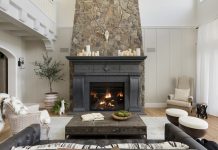Architecture: Charlie & Co. Design
Builder: John Kraemer & Sons
Interior Design: Twist Interior Design

When a young couple was ready to move out of their Lowertown loft in St. Paul, they knew the kind of home they were looking for. The husband, a longtime resident of St. Paul, not only wanted to remain in the city, but also wanted to live in a house with history—and to take the time and effort to lovingly restore it to its original glory. They found their new home in an old, four-story mansion originally built in 1907 and designed in a traditional Jacobethan-Tudor style. “We did look at one new build—he did it for me—but he hated it,” says the wife, laughing. “But he loved the style of this home and we both wanted to celebrate its history by preserving the period details and just being good stewards.”

The home, while stunning, needed a lot of renovation work. So the couple contacted local construction experts John Kraemer & Sons to discuss where to begin. Due to the size and scale of the home, the project was split into phases. The first, which initially began as a remodel of the kitchen and master bedroom, ended up encompassing the first two floors and part of the third floor. The kitchen was completely gutted and remodeled, and the rest of the first floor completely restored. “We left all the original woodwork, moldings, and ceiling details and just added fresh coats of stains and cleaned up the plaster work,” says Jeff Kraemer, who managed the project. “The second and third floors were in a much worse state of disrepair, so we did a full gut on those floors.”


The kitchen, built at a time when the space was used for service (and not as an area for the homeowners to entertain), was originally two rooms the previous owner had combined into one large space that was dark, had little to no counter space, and looked, as interior designer Sandy LaMendola of Twist Interior Design describes, “like a church basement kitchen.” The architect, Charlie Simmons of Charlie & Co. Design, ended up flipping the original layout and dividing it into several interconnected spaces including the cooking area, which he brought over to the windows to allow for more natural light, the informal eating area which he tucked back in the corner, and a butler’s pantry located off to the side.


“The clients didn’t want an overly stuffy white kitchen, so we brought in some darker shades with the island and paint colors,” explains Simmons. “But they’re so happy we went with the white cabinetry and lighter countertops because the rest of the home is so dark.” He also added subtle curves in the island, scrolls on both sides of the range, and marble wings above the countertop to cater to the client’s more organic tastes. “Those softer details help bring in shape and flavor in a relatively traditional styled kitchen,” he says.
The same organic theme is continued in the small apothecary off the kitchen (which the wife, a practitioner of ayurvedic medicine, uses to mix her medicines and teas) as well as the home’s solarium, both of which feature Moroccan designs, rich textures, and unique architectural details. “Clients have more than one facet to their personalities, so we like to express a variety of moods within their homes to reflect that,” says LaMendola. “With the solarium, the client wanted a cozy place to relax, so we brought in a jumbo-size daybed and loaded it up with softness and texture.” In-floor heating was installed for warmth, as well as additional lanterns and sconces to brighten up the space (though the room’s original light fixture was kept). While the tile flooring ended up having to be replaced, the bottle-green color of the original tiles was saved as well.

A space the team was particularly passionate about preserving was the dining room, fully paneled in wood and featuring hand-carved plaster moldings and an intricate ceiling pattern. However, it had once been used as a smoking room, so the wall details and ceiling—both white once upon a time—had stained yellow after years, and the limestone fireplace had numerous cracks, including one right down the middle that was so bad Simmons questioned how the structure was still standing. After a buff-and-shine job on the plaster moldings, an artist was brought in to hand-paint the details, while the fireplace was shipped to a quarry in Mankato where craftsmen used limestone dust and glue to fill in the cracks. “They washed it down to its original stone, shipped it back, and now the crack’s only visible from about two inches away,” says Simmons. “We love how it’s the original one, the one designed for the home, and not a replica. It’s part of the DNA and history of the house.”

While the first two floors were remodeled in a traditionally historic fashion, more modern liberties were taken with the third floor, originally the servants’ quarters and fondly dubbed the “amusement park” level by the clients due to the variety of rooms it now holds. “Moving into a place of this size, the most important thing to me was making sure every room had a purpose,” says the client. “We didn’t want six bedrooms that would never be used, so we changed them up with offices, a playroom for the kids, and a home theater.” Two bedrooms were kept for guests, along with two bathrooms designed in “his-and-hers” styles with the former featuring an urban, industrial feel, and the latter a pampering spa-like atmosphere.

Both husband and wife have offices as well; the wife’s designed in her favored Moroccan style with a Zen-like ambiance perfect for meditation, while the husband’s office is actually the interior of an executive train car, designed from a late-1800s model, that was constructed offsite, shipped to the home, and reconstructed. “The husband’s office is a really special space; all wood paneling and custom stained-glass windows,” says Simmons. “Plus it has a whole bunch of little tricks to it, from the vintage train bell and Atwater Kent radio to the real train wheel that was turned into his standing desk.”


Other distinct spaces include the home’s map room, which features a partial barrel vault ceiling and a door leading up to an observatory (complete with rotating telescope), and the home theater—once a trunk room where servants would store luggage and extra furniture. “The client had grown up going to movies at St. Paul’s original Grandview Theater, and he wanted the same Art Deco look and feel with the red seats and crushed velvet walls,” says Simmons, who replicated the effect through thoughtful details like a cabinet created in the style of an old ticket booth and sound equipment hidden behind pillars with historic detailing done in naval brass.
“It was a once-in-a-lifetime opportunity to work on a project like this, one where the client simply said, ‘Do whatever is right for the home.’ You mix that client and the right piece of property with a team who cares deeply about doing things right, and you end up with something magical,” says Simmons. “It’s really a brand-new house, wrapped up in a historic shell.”

Anna Bjorlin is managing editor of Midwest Home.




















